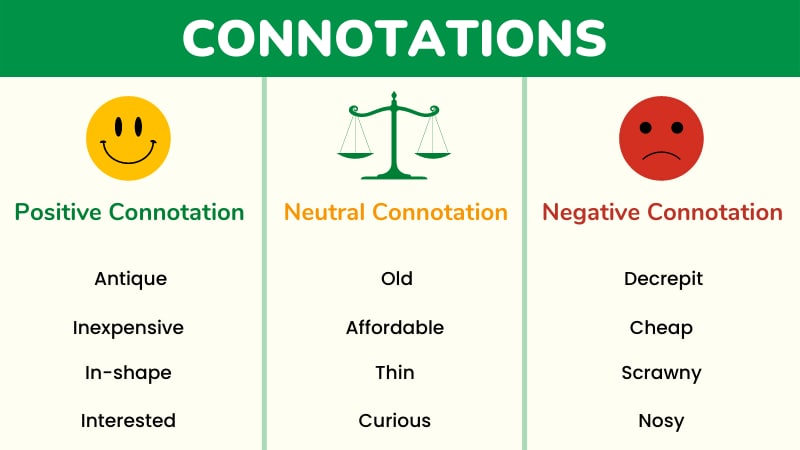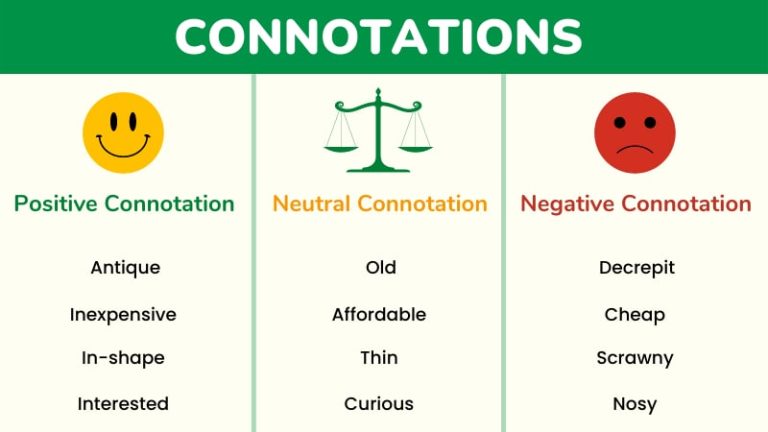Understanding sentence of connotation can transform how you communicate and interpret language. Most people struggle with hidden meanings in everyday conversations.
The truth is, every word carries emotional weight beyond its basic definition.
This guide breaks down connotation in simple terms so you can master this powerful language tool.
You’ll discover how connotation shapes meaning, influences emotions, and creates impact in writing and speech.
Let’s dive into the world of hidden meanings together.

What Is a Sentence of Connotation?
A sentence of connotation uses words that carry emotional or cultural associations beyond their literal meaning.
Think of it this way: denotation tells you what something IS, while connotation tells you how it FEELS.
Every word you choose creates a specific emotional response in your reader’s mind.
For example, calling someone “cheap” versus “thrifty” changes the entire message.
Both words mean someone who spends little money, but they create completely different feelings.
The power lies in choosing words that trigger the exact emotional response you want.
Key Components of Connotative Sentences
Emotional Triggers: Words that spark specific feelings or reactions
Cultural Context: Meanings that vary based on society and background
Personal Associations: Individual experiences that shape word interpretation
Tone Creation: How word choice establishes mood and atmosphere
Implied Meaning: Messages communicated without direct statement
Types of Connotation in Sentences
Positive Connotation
Positive connotation creates favorable impressions and good feelings.
These words make readers feel optimistic, happy, or impressed.
Examples:
- “She’s a determined leader” (shows strength)
- “He’s got a youthful appearance” (suggests vitality)
- “Their home is cozy” (feels warm and inviting)
Negative Connotation
Negative connotation triggers unfavorable emotions and bad impressions.
These words create discomfort, disapproval, or negative associations.
Examples:
- “She’s a stubborn leader” (shows inflexibility)
- “He looks childish” (suggests immaturity)
- “Their home is cramped” (feels uncomfortable)
Neutral Connotation
Neutral connotation delivers information without emotional influence.
These words focus on facts rather than feelings.
Examples:
- “She’s a persistent leader” (factual description)
- “He appears young” (simple observation)
- “Their home is small” (size description only)
How Connotation Works in Communication
The Psychology Behind Word Choice
- Your brain processes connotative meaning faster than denotative meaning.
- This happens because emotions trigger quicker responses than logical thinking.
- When someone says “vintage car,” you immediately picture something valuable and classic.
- But hearing “old car” makes you think of something worn-out and unreliable.
- Same object, completely different mental images.
Cultural Influence on Connotation
- Different cultures attach different meanings to the same words.
- What sounds positive in one culture might seem negative in another.
- Understanding your audience’s cultural background helps you choose better words.
- For instance, calling someone “aggressive” in business can be positive in some cultures but negative in others.
Context Shapes Meaning
- The situation determines how people interpret connotative language.
- A word that works in casual conversation might fail in formal writing.
- Professional settings require different connotative choices than personal conversations.
- Smart communicators adjust their word selection based on the environment.
Examples of Connotation in Different Contexts
Literature and Creative Writing
Authors use connotation to create atmosphere and develop characters.
Example 1: “The ancient mansion loomed against the stormy sky”
- “Ancient” suggests mystery and history
- “Loomed” creates a threatening feeling
- “Stormy” adds danger and drama
Example 2: “The charming cottage nestled in the peaceful valley”
- “Charming” creates attraction and warmth
- “Nestled” suggests safety and comfort
- “Peaceful” promotes calm and relaxation
Business Communication
Professional writing uses connotation to influence decisions and create trust.
Marketing Example: “Premium quality ingredients” vs “Expensive ingredients”
- Both describe costly materials
- “Premium” suggests value and excellence
- “Expensive” focuses on high cost
Resume Example: “Spearheaded innovative solutions” vs “Tried new things”
- Both describe attempting new approaches
- “Spearheaded” shows leadership and success
- “Tried” suggests uncertainty and possible failure
Everyday Conversations
Daily interactions constantly use connotative language.
Example: Describing someone’s cooking
- “That’s interesting” (polite way to say you don’t like it)
- “That’s delicious” (genuine appreciation)
- “That’s unique” (diplomatic criticism)

The Impact of Connotation on Reader Response
Emotional Engagement
- Connotative language connects with readers on an emotional level.
- Facts inform, but emotions motivate action.
- When you write “She discovered a solution,” it sounds academic.
- But “She uncovered a breakthrough” creates excitement and achievement.
- The second version makes readers feel more engaged and interested.
Persuasion and Influence
Smart word choices can change minds and influence decisions.
Politicians, marketers, and leaders understand this power.
They carefully select words that create desired emotional responses.
Example: “Tax relief” vs “Tax cuts”
- Both mean reducing taxes
- “Relief” suggests help from burden
- “Cuts” implies reduction or loss
Building Relationships
Connotation helps build stronger connections between communicators.
Positive connotative language creates trust and rapport.
Negative connotation can damage relationships and create misunderstandings.
Choose words that strengthen rather than weaken your connections.
Common Connotation Mistakes to Avoid
Using Inappropriate Tone
- Mismatched tone destroys your message effectiveness.
- Formal language in casual settings sounds stiff and disconnected.
- Casual language in professional contexts appears unprofessional.
- Match your connotative choices to your audience and situation.
Ignoring Cultural Differences
- Assuming everyone shares your cultural associations creates problems.
- Words that seem positive to you might offend others.
- Research your audience’s background before choosing connotative language.
- When in doubt, choose neutral terms that don’t risk misunderstanding.
Overdoing Emotional Language
- Too much connotative language overwhelms readers.
- Balance emotional words with neutral, factual language.
- Constant emotional manipulation makes people distrust your message.
- Use connotation strategically, not constantly.
Practical Strategies for Using Connotation Effectively
Know Your Audience
Understanding your readers helps you choose appropriate connotative language.
Age Groups: Different generations respond to different word associations
Professional Background: Industry-specific terms carry unique connotations
Cultural Identity: Shared cultural experiences shape word meanings
Personal Interests: Hobbies and passions influence word interpretation
Choose Words Deliberately
Every word choice should serve a specific purpose.
Ask yourself: “What feeling do I want to create here?”
Replace weak words with stronger connotative alternatives.
Weak: “The meeting was good” Strong: “The meeting was productive”
Test Your Word Choices
Read your writing aloud to hear how it sounds.
Consider how different people might interpret your words.
Ask others to review your writing for unintended connotations.
Revise words that don’t create your desired emotional response.
Advanced Connotation Techniques
Layered Connotation
Expert writers combine multiple connotative words for powerful effect.
Each word reinforces the overall emotional message.
Example: “The sleek, innovative design revolutionized the industry”
- “Sleek” suggests modern elegance
- “Innovative” implies creativity and progress
- “Revolutionized” shows dramatic positive change
Contrasting Connotations
Juxtaposing different connotative words creates tension and interest.
This technique highlights differences and creates memorable phrases.
Example: “Brutal honesty” combines negative and positive connotations
Subtle Connotation
Sometimes the most powerful connotation works almost invisibly.
Readers feel the emotional impact without noticing the technique.
This approach builds trust because it doesn’t feel manipulative.
Example: “We’re facing some challenges” vs “We’re dealing with problems”
Industry-Specific Connotation Examples
Healthcare Communication
Medical professionals use connotation to provide comfort and hope.
Positive: “Your condition is manageable” Negative: “Your disease is incurable” Neutral: “Your diagnosis requires ongoing treatment”
Legal Writing
Lawyers choose words that support their client’s position.
Favorable: “My client made an error in judgment” Unfavorable: “The defendant committed a crime” Neutral: “The incident occurred on Tuesday”
Educational Content
Teachers use connotation to motivate and encourage students.
Encouraging: “This concept builds on your existing knowledge” Discouraging: “This topic is extremely difficult” Neutral: “This lesson covers advanced material”
Measuring Connotation Effectiveness
Reader Response Indicators
Engagement Metrics: Time spent reading, comments, shares
Emotional Reactions: Positive or negative feedback
Action Rates: Click-through rates, conversions, responses
Comprehension Levels: Understanding and retention tests
Testing Methods
A/B Testing: Compare different connotative word choices
Focus Groups: Gather feedback on emotional responses
Surveys: Measure reader reactions to specific phrases
Analytics: Track behavior changes based on word choices

Building Your Connotation Skills
Daily Practice Exercises
Word Substitution: Replace neutral words with connotative alternatives
Emotion Mapping: Identify the emotional impact of different word choices
Context Switching: Practice adapting connotation to different situations
Audience Analysis: Study how different groups respond to specific words
Reading for Connotation
Analyze Literature: Notice how authors use connotation for effect
Study Advertisements: Observe commercial connotation techniques
Read News Articles: Compare how different sources describe the same events
Examine Social Media: See how connotation shapes online conversations
Writing Practice
Rewrite Sentences: Transform neutral statements into connotative ones
Create Mood Pieces: Write paragraphs that establish specific emotions
Develop Characters: Use connotation to reveal personality traits
Practice Persuasion: Write arguments using strategic word choices
Common Questions About Connotation
What’s the difference between connotation and denotation?
Denotation is the literal, dictionary definition of a word.
Connotation includes all the emotional and cultural associations.
For example, “snake” denotes a reptile but connotes danger or deception.
Can connotation change over time?
Yes, connotations evolve as culture and society change.
Words that once had positive connotations might become negative.
Social movements and historical events reshape how we interpret language.
How do I know if my connotation is working?
Monitor your audience’s responses and reactions.
Look for engagement, emotional reactions, and desired actions.
Test different approaches and measure the results.
Is connotation manipulation?
Connotation is a natural part of language and communication.
Using it responsibly helps clarify meaning and connect with others.
Problems arise when connotation is used to deceive or mislead.
How do you use connotation in a sentence?
“The word ‘home’ has a warm, comforting connotation beyond its literal meaning.” Connotation adds emotional or cultural meaning to a word.
What is a sentence for student connotation?
“The term ‘nerd’ once had a negative connotation, but many students now wear it proudly.” This shows how perception can shift over time.
What are the connotations of short sentences?
Short sentences often connote urgency, tension, clarity, or emphasis in writing, especially in dialogue or dramatic scenes.
How do you use connote in a sentence?
“The color black often connotes elegance, power, or even mystery.” “Connote” means to imply or suggest additional meanings.
What are 5 examples of connotation?
-
Childish (negative) vs. Youthful (positive)
-
Cheap (negative) vs. Affordable (positive)
-
Stubborn vs. Determined
-
Slim vs. Skinny
-
Confident vs. Arrogant
What is the connotation of easy?
“Easy” often connotes something simple, stress-free, or lacking challenge—depending on context, it can sound either helpful or dismissive.
The Future of Connotative Communication
Digital Age Adaptations
- Online communication requires new connotative strategies.
- Emojis, hashtags, and internet slang carry strong connotations.
- Understanding digital connotation helps you communicate effectively online.
Artificial Intelligence and Connotation
- AI systems are learning to recognize and generate connotative language.
- This technology will change how we approach written communication.
- Human understanding of connotation remains valuable and necessary.
Global Communication Challenges
- As the world becomes more connected, connotative differences become more important.
- Cross-cultural communication requires sensitivity to different associations.
- Universal connotative principles can help bridge cultural gaps.
Conclusion
Mastering sentences of connotation transforms your communication power.
Every word choice creates emotional impact and influences your audience.
Understanding positive, negative, and neutral connotations helps you choose better words.
Practice identifying connotative language in everything you read and hear.
Start applying these techniques in your own writing and speaking.
Remember that connotation works best when it serves your audience’s needs.
Use this knowledge to build stronger connections and communicate more effectively.
The journey to connotative mastery begins with your next conversation.

